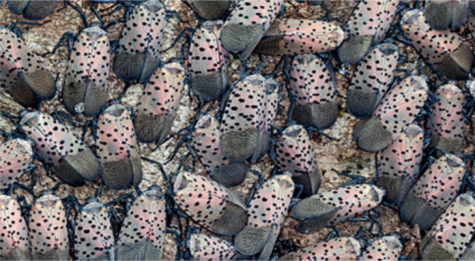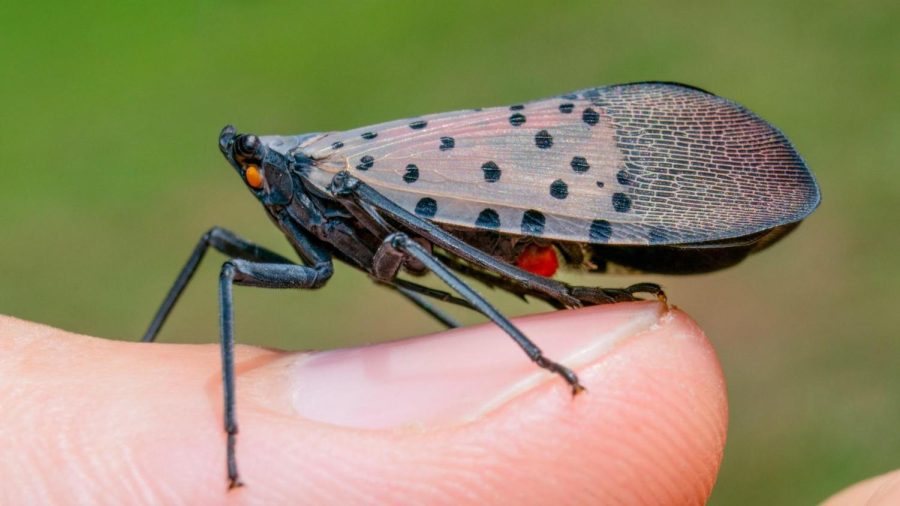The Spotted Lanternfly Invasion
February 24, 2022
Is it a moth? Is it a butterfly? No, it’s a planthopper called the spotted lanternfly! These moth-like bugs are beautiful, yet extremely harmful to farmers and the economy. The lanternfly is native to Asia, but has spread to multiple countries including the United States.
These sap-feeding insects lay their eggs on many different hosts, including plants important to the economy. They reproduce very rapidly and are wreaking havoc on crops in America.
Spotted lanternflies were first seen in the U.S. in Pennsylvania back in 2014, but are becoming increasingly prevalent today. By late 2021, they were spotted in 20 states and that number continues to grow. The insects lay between 30 and 50 eggs at a time on not only plants, but also things like cars, shipping crates, and even airplanes. This is one contributing factor to their appearance in continents other than Asia.
 Lanternflies feed on sap from over 60 species of plants and trees. Their feces are what is killing crops all across the country. The lanternflies excrete a sugary substance called honeydew, which attracts a type of mold that slowly weakens and kills plants. This black, sooty mold is harmless to people but can cause wilting, leaf curling, and invasive vine growth on plants.
Lanternflies feed on sap from over 60 species of plants and trees. Their feces are what is killing crops all across the country. The lanternflies excrete a sugary substance called honeydew, which attracts a type of mold that slowly weakens and kills plants. This black, sooty mold is harmless to people but can cause wilting, leaf curling, and invasive vine growth on plants.
These spotted troublemakers target economically-vital plants and are greatly damaging the agricultural economy. Pennsylvania has been invaded by lanternflies for many years and their economy is enduring substantial hits. Pennsylvania’s grape-growing, hardwood, nursery, tree fruit, and landscape industries are all at risk if lanternflies continue to take over. These specific industries generate $18 billion every year and contribute largely to the U.S. agricultural economy as a whole. This affects roughly 3,000 agricultural jobs in Pennsylvania alone, leaving farmers and others without work.
Spotted lanternflies have a very distinct appearance. When their wings are closed, they appear a light brown color with a section of large black dots scattered along their wings and a section of smaller, clumped dots towards the wing’s end. When they open their wings, red, yellow, white, and black can be seen.  Their hind wings have red and black patches with a white band, and their yellow abdomen with black bands resembles that of a bee. The lanternfly eggs are laid within a gray, foamy substance and somewhat resemble rice pudding. Typically, the egg masses can be found on flat surfaces.
Their hind wings have red and black patches with a white band, and their yellow abdomen with black bands resembles that of a bee. The lanternfly eggs are laid within a gray, foamy substance and somewhat resemble rice pudding. Typically, the egg masses can be found on flat surfaces.
When you see a spotted lanternfly or lanternfly eggs, kill or squish them. In the spring, lanternflies begin to lay their eggs and they hatch very soon after. If enough people are able to smash the eggs before they are able to become grown lanternflies, the destruction of these invaders can be prevented. Killing lanternflies can not only help plants, but also the U.S. agricultural industry.
Killing a spotted lanternfly is a surprisingly easy task. The insects are prenatal, meaning they will not fight back or try to jump or fly away. Any squishing, stomping, or killing method works as long as the lanternfly has been exterminated. Getting rid of the eggs presents more of a challenge, but the use of a credit card, license, or business card makes it much easier. Scrape the egg mass with one of these items and make sure to reach each and every egg. Juice may spill from the pile, which is how you know your scraping is effective. Eliminating these eggs ensures there will be at least 30 to 50 fewer future lanternflies.
Whether you have just seen or killed a lanternfly, reporting them is crucial to help the country keep track of how many of these crop-killing bugs there are. A report could either consist of a photograph of the insect, an email, phone call, or message. These reports are used by the government and the U.S. Department of Agriculture (USDA) to stop the spread and gain a better understanding of this invasive species’ population. Taking action and squashing even a few of these planthoppers has a large impact on stopping the spread.





